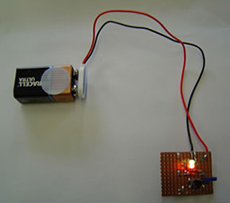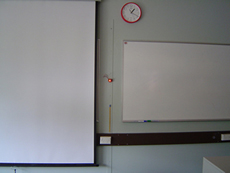Abstract

Red and green LEDs blend to make yellow light when viewed from a distance.
The photo at right was taken at an intermediate distance where the light appears to be red and green on the edges but yellow in the middle.
Portable
Yes
Principles Illustrated
Resolution of the human eye and additive colour mixing.
NCEA & Science Curriculum

Jnr Sci
Instructions

It is suggested that this demo can follow a colour mixing demo in which students observe that red light and green light together appear yellow. In this demo, one red LED and one green LED are mounted on a circuit board as close together as possible. The LEDs can be filed down a bit to get them closer together. The variable resistor adjusts the relative intensity of the two LEDs. From a distance of 15 metres or so students see mostly a yellow light with green and red edges. As the students move toward the lights it is revealed to them that actually no yellow light is present. This serves to reinforce the idea that red plus green make yellow, but the demonstration goes beyond that. First, one can use this apparatus to measure the order of magnitude of the angular resolution of the human eye. As you move back from the LED to a distance where yellow appears at the centre, you are no longer resolving the two LEDs separately. Expect an angular resolution on the order of 10-4 radians. But note the measured resolution of the human eye will depend on the brightness of the sources and other factors. Measurements may involve black dots on a white background. This demonstration shows the idea and is not intended as a careful measurement.

In addition, students can learn that modern image technology (cameras, TV cathode ray tubes and computer screens, etc) are based on RGB (red green blue) technology. When you see a yellow sunflower on a display there is no yellow light coming from the pixels. Instead there is red light and green light. This “fools” the human eye which detects colour via three kinds of cones. Red light plus green light causes the same response in the cones that would be caused by yellow light and thus the combination appears yellow. In some sense RGB technology is all an illusion.
This demo is difficult to film because cameras lack the resolution and dynamic range of the human eye. But it is easy to construct the demonstration apparatus and this is a portable demo that we can bring to Wellington area schools.
Use of this demonstration can be followed by looking at a colour TV CRT or a colour LCD display with a magnifying glass.
This demonstration is part of a package of human eye demos that we can do at local schools. The entire show takes perhaps thirty to ninety minutes depending on which demonstrations and activities are selected.
Safety
Individual teachers are responsible for safety in their own classes. Even familiar demonstrations should be practised and safety-checked by individual teachers before they are used in a classroom.
Related Resources
Teaching Resources
Would you like to contribute lesson suggestions? Contact us.
Credits
This teaching resource was developed with support from
The MacDiarmid Institute
Faculty of Science, Victoria University of Wellington
School of Chemical and Physical Sciences, Victoria University of Wellington